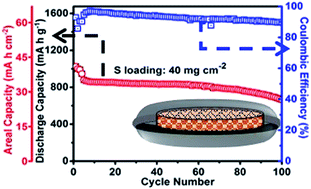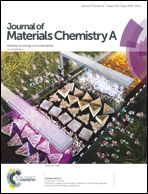A nickel-foam@carbon-shell with a pie-like architecture as an efficient polysulfide trap for high-energy Li–S batteries†
Abstract
A high-loading sulfur cathode is critical for establishing rechargeable lithium–sulfur (Li–S) batteries with the anticipated high energy density. However, its fabrication as well as realizing high electrochemical utilization and stability with high-loading sulfur cathodes is a daunting challenge. We present here a new pie-like electrode that consists of an electrocatalytic nickel-foam as a “filling” to adsorb and store polysulfide catholytes and an outer carbon shell as a “crust” for facilitating high-loading sulfur cathodes with superior electrochemical and structural stabilities. The inner electrocatalytic nickel-foam is configured to adsorb polysulfides and facilitate their redox reactions. The intertwined carbon shell assists to shield the polysulfides within the cathode region of the cell. Both the nickel-foam and the carbon shell have high conductivity and porous space, which serve simultaneously as interconnected current collectors to enhance the redox kinetics and as polysulfide reservoirs to confine the active material. The effectiveness of such a pie-like structure in improving the electrochemical efficiency enables the cathode to host an ultrahigh sulfur loading of 40 mg cm−2 and attain a high areal capacity of over 40 mA h cm−2 at a low electrolyte/sulfur (E/S) ratio of 7. The enhanced cyclability is reflected in a high reversible areal capacity approaching 30 mA h cm−2 at C/5 rate after 100 cycles and excellent rate capability up to 2C rate.



 Please wait while we load your content...
Please wait while we load your content...